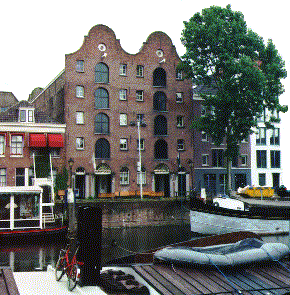n 1389 the city of Delft got permission by count
Aelbrecht of Bavaria to dig its own shipping link between Overschie and the
Nieuwe Maas (Rhine). This way Delft got its own open shipping link to the sea
and was no longer
obliged to pay tolls to the city of Rotterdam. The Delft textile and beer
industries were heavily geared to export. Rotterdam was one of its main rivals.
Around the lock between the new canal (Delfhavense Schie) and the Nieuwe Maas a
new settlement arose which was directly governed from Delft itself. This
situation continued until 1811 when Delfshaven managed to gain independence. The
town received its own coat of arms representing its main trades: fishing (herring) and gin. The new town went into an economic recession and 1886 the town
was incorporated into Rotterdam. After decades of neglect the area received new
attention in the 1970s when a start was made with the reconstruction and
renovation of the historic buildings. A cautious attempt was made to introduce
some new building. In the 1990s the council started actively promoting the
establishment of art galleries, restaurant and café’s, which has left
Delfshaven with an attractive nightlife.
Delfshaven has some interesting sights. Eye catching is the Zakkendragershuisje (Voorhaven 13-15) This building from 1653, was first a lock house, a guild house for the dock workers, a prison and a fire station. These days it houses a traditional tin workshop.
Open Tue thru Fri 10-17, Sat, Sun- and holidays 11-17 hrs. Closed on 1 Jan, 30 Apr 25 dec annd mondays (except Easter, Whitsunday, and Boxing Day. Demonstrations last 20-30 minutes. Free demonstrations on Sundays at 14, 15 and 16 hrs.
A bit further down the street Aelbrechtskolk nr.
12 is the former town hall. The town’s coat of arms is hanging over the
front door. It symbolises Delfshaven’s main trades at the time of its
founding: fisheries (herring) and gin. From 1554 onwards the building has housed
the governors from Delft. In 1721 the town hall is completely refurbished and in
1791 the facade is renewed. The original was replaced by the present
neoclassical one. At independence in 1795 it becomes a real town hall. After
incorporation into Rotterdam it becomes a police station and later serves as a
historic museum. Restoration works in 1970 mean the removal of the white
plaster work from the facade giving it its present look. Since 1994 the building
serves as a bar and restaurant. A special one at that, as it brews its own beer.
Tours are possible after reservation from f 12,50 p.p. The tour involves a look
at the kettles, information about ingredients and the brewing process. After the
tour one gets to taste three kinds of
Pelgrim Beers and a piece of Pelgrim Cheese.
At Aelbrechtskolk 20 is the old or Pilgrim fathers’ church. This church’s claim to fame is based on the fact that a group of puritan protestants spent their last night in Holland here, before they set sail for the New World. The group had escaped England in 1609 and established itself in Leiden. Their leader, reverend John Robinson had a flock of about 200 people in 1620. These protestants were free to worship the way they wanted, but as foreigners not free to choose any occupation they wanted. Their financial reserves were depleted and the group became quite impoverished. In 1620 they decided to leave for America. Before the crossing with the Speedwell to England (Southampton) and on with the Mayflower to America (Pennsylvania), the group spent its last night in this church. For this reason the church is a favourite among American visitors. The church itself dates back to ± 1500 and has a clock from 1464. In 1761 the church was refurbished. Its interior contains a number of rare medieval elements.
At Voorhaven 12 is the historic museum De
Dubbelde Palmboom (the double palm tree). It consists of two former
warehouses, built in 1825 as the grain warehouse Denmark. Around 1860 a gin
distillery was based here  and
the name changed tot Dubbelde Palmboom. The museum’s exhibition is put
together around the theme: crossroads Rotterdam. The port has been a gateway for
foreign products, people and ideas throughout the centuries. This has influenced
the life of the Rotterdam people immensely.
and
the name changed tot Dubbelde Palmboom. The museum’s exhibition is put
together around the theme: crossroads Rotterdam. The port has been a gateway for
foreign products, people and ideas throughout the centuries. This has influenced
the life of the Rotterdam people immensely.
Open: Tue-Fri 10.00-17.00 hrs; sat, sun and hols 11.00-17.00 uur; closed. Mondays (except Easter, Whitsunday and Boxing Day) and on 1 Jan, 30 Apr, 25 Dec.